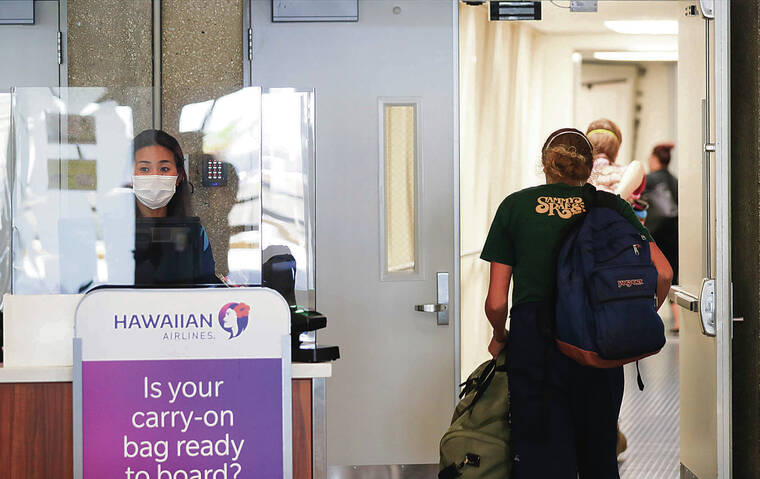Hawaiian Airlines loses $9.3 million amid Japan visitor lag

JAMM AQUINO / 2020
Passengers board a Hawaiian Airlines flight bound for Portland, Ore., at Daniel K. Inouye International Airport.
A continued lag in visitors from Japan to Hawaii and a protracted interisland fare war with competitor Southwest Airlines were among the headwinds that Hawaiian Holdings Inc., the parent company of Hawaiian Airlines, faced before reporting a third-quarter loss.
Hawaiian reported Tuesday a third-quarter loss of $9.3 million, after reporting a $14.7 million profit in the same period a year earlier. On a per-share basis, the Honolulu-based company said it had a loss of 18 cents. Losses, adjusted for nonrecurring costs, were 15 cents per share.
The results exceeded Wall Street expectations. The average estimate of four analysts surveyed by Zacks Investment Research was for an adjusted loss of 19 cents per share. The parent company of Hawaiian Airlines posted revenue of $741.2 million in the period, which did not meet Street forecasts. Three analysts surveyed by Zacks expected $750.8 million.
At closing on Tuesday, Hawaiian’s stock had dropped a nickel to $15.25.
Peter Ingram, president and CEO at Hawaiian Airlines, said during Tuesday’s conference call, “Demand for travel to, from and within Hawaii remains strong.”
“Operationally, we had a solid summer relative to some of the challenges elsewhere in the industry, but relative to our own high standards, we are not yet where we want to be.”
Don't miss out on what's happening!
Stay in touch with breaking news, as it happens, conveniently in your email inbox. It's FREE!
During the third quarter of 2022, Hawaiian reported that it was back to 93% of its 2019 third-quarter system capacity. Capacity from North America exceeded 2019 at 116% of that peak year’s capacity. However, neighbor island routes were back to only 82% of 2019, while the recovery rate was 52% for international routes.
“Outside of Japan, we have also seen a strong recovery on our international routes, overcoming the strength of the U.S. dollar and demonstrating that the robust desire for leisure travel is not a uniquely American phenomenon,” Ingram said. “Sydney, in particular, has seen notable demand strength.”
Still, the delay in Japanese visitors returning to Hawaii factored into Hawaiian’s expectation that capacity in the fourth quarter will be down about 4% to 7%. However, the airline expects demand from domestic and international bookings to boost fourth-quarter revenue by about 3.5% above 2019.
Ingram noted that Japan on Oct. 11 removed most of its pandemic travel restrictions, including testing requirements for international arrivals and the hard cap on the number of international arriving passengers.
“We anticipate a solid recovery in Japan-Hawaii travel in the coming months, but mindful of the cautious nature of the Japanese public and the continuing weakness of the Japanese yen relative to the U.S. dollar, we’re choosing to add capacity back gradually,” he said.
Brent Overbeek, Hawaiian’s senior vice president and chief revenue officer, said during the investor call that the airline plans to restore Japan capacity throughout the next couple of quarters with a full Japan schedule in place by the second quarter of 2023.
Hawaiian’s strategic plans also include continuing to aggressively defend its position as the “primary provider of interisland transportation.”
Prior to the pandemic, Ingram said, Hawaiian’s neighbor island routes accounted for a little over 20% of its passenger revenue, a substantial contribution, albeit smaller than its North America and international flying.
“But the percentage revenue contribution from these routes understates their importance to our business,” he said. “The origin of our company, almost 93 years ago, was flying between the islands of Hawaii. And we’ve been the primary provider of interisland transportation ever since. In addition to serving as the interisland highway system for the state, these operations provide essential connection capacity for our long-haul flights, enabling our North America and international operations to function at the scale we provide, despite its limited connecting capacity outside of Hawaii.”
Hawaiian offers approximately 130 daily flights within the Hawaiian Islands, daily nonstop flights between Hawaii and 15 U.S. gateway cities as well as service connecting Honolulu and American Samoa, Australia, Japan, New Zealand, South Korea and Tahiti.
During the third quarter, Southwest Airlines significantly increased interisland trips, which by Sept. 6 were around 60 a day from an earlier 38. Southwest supported its expansion with an aggressive $39 fare on every seat for every nonstop interisland flight, which began July 26 and will run through Dec. 31.
Ingram said, “These $39 fares include federal taxes, which means the company receives $26.05 from each ticket sold. These fares, even if 100% of seats are occupied, do not cover the cost of operations.”
He added, “For so long as these deeply discounted fares persist, we’ll see lower returns from our neighbor island roots. Exactly how long this will last is difficult to predict at this time, but for now it will be a headwind to the recovery of our bottom line.”
Ingram said he did not know how the competitive interisland situation would evolve in the months ahead.
“What I do know is that the appropriate response to this challenge is to compete. So, we’ll lean in,” he said.
Ingram said Hawaiian is adding flights to meet demand for travel, and has made $39 interisland fares broadly available through the remainder of the year. He said HawaiianMiles members will receive double miles on neighbor island flights through the end of the year. HawaiianMiles credit card holders now receive two bags free on every flight, Ingram added.
“Over the past nine decades, we’ve absorbed competitive challenges on various fronts, and throughout we’ve prevailed, in large part due to our singular focus on serving the needs of Hawaii travelers better than any competitor,” he said.
———
The Associated Press contributed to this story.
THIRD-QUARTER LOSS
$9.3 million
YEAR-EARLIER NET
$14.7 million



